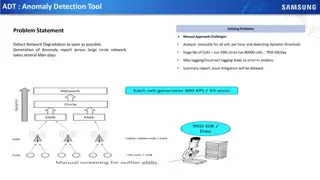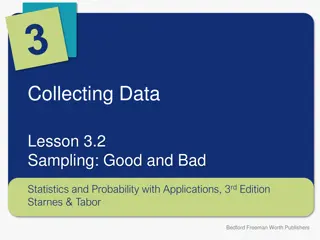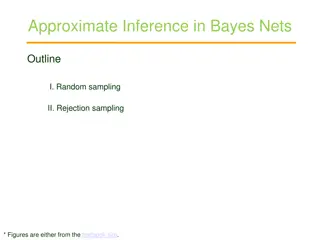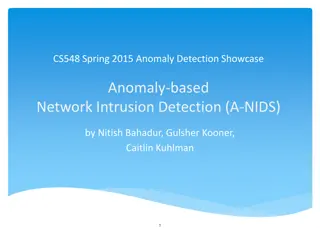Principled Sampling for Anomaly Detection: An Insightful Approach
This study delves into principled sampling for anomaly detection, emphasizing the trade-offs, the importance of accurate error estimation, and the need for tuned detectors. It discusses the estimation of error rates, what is required from test generators, and the significance of massive output capabilities. With a focus on representative distribution sampling and statistical bounds, the research aims to enhance anomaly detection accuracy and efficiency.
Uploaded on Feb 16, 2025 | 1 Views
Download Presentation

Please find below an Image/Link to download the presentation.
The content on the website is provided AS IS for your information and personal use only. It may not be sold, licensed, or shared on other websites without obtaining consent from the author.If you encounter any issues during the download, it is possible that the publisher has removed the file from their server.
You are allowed to download the files provided on this website for personal or commercial use, subject to the condition that they are used lawfully. All files are the property of their respective owners.
The content on the website is provided AS IS for your information and personal use only. It may not be sold, licensed, or shared on other websites without obtaining consent from the author.
E N D
Presentation Transcript
PRINCIPLED SAMPLING FOR ANOMALY DETECTION Brendan Juba, Christopher Musco, Fan Long, Stelios Sidiroglou-Douskos, and Martin Rinard
Anomaly detection trade-off Catch malicious/problematic inputs before they reach target application. Do not filter too many benign inputs.
Detectors need to be tuned! Benign Error Rate Aggressiveness
Requires accurate error estimation Shooting for very low error rates in practice: .01% Cost of false positives is high Benign Error Rate Aggressiveness
Estimating error rate Anomaly Detector Pass Reject Estimated Error Rate: (# falsely rejected inputs)/(# total inputs)
Whats needed from a test generator? Anomaly Detector Reject Pass
1) Massive output capability With 99% confidence, estimated error rate accurate to within .01% Need 1/ log(1/ ) 46,000 samples Standard Techniques Hoeffding bounds, etc.
1) Massive output capability Benign Error Rate Aggressiveness
2) Samples from representative distribution Typical vs. Testing Testing Inputs Typical Inputs
2) Samples from representative distribution With 1/ log(1/ ) samples : from distribution D With 99% confidence , estimated error rate accurate to within .01% for inputs drawn from distribution D . Only meaningful for similar distributions!
Meaningful statistical bounds With 99% confidence, our anomaly detector errs on <.01% of benign inputs drawn from distribution D . With 99% confidence, our anomaly detector errs on <.01% of benign inputs seen in practice .
Easier said than done Samples need to be: Cheap to generate/collect. Representative of typical input data. 1 2 Getting both speed and quality is tough.
Possible for web data Claim: We can quickly obtain test samples from a distribution representative of typical web inputs. Fortuna: An implemented system to do so.
Random Search Web Data: Images, JavaScript files, music files, etc. mit.edu reddit.com npr.org christophermusco.com harvard.edu patriots.com news.google.com wikipedia.org dblp.de nfl.com scholar.google.com espn.com arxiv.org
Not enough coverage Typical vs. Testing Testing Inputs Typical Inputs
Explicit Distribution Can obtain a very large (although not quite complete) index of the web from public data sources like seahawks.com m facebook.co wikipedia.org patriots.com google.com arxiv.org dblp.de ask.com cnn.com mit.edu npr.org
Uniform sampling not sufficient Typical vs. Testing Testing Inputs Typical Inputs
Can weight distribution seahawks.com m facebook.co wikipedia.org patriots.com google.com arxiv.org dblp.de ask.com cnn.com mit.edu npr.org
Computationally infeasible Need to calculate, store, and share weights (based on traffic statistics, PageRank, etc.) for ~2 billion pages. Weights will quickly become outdated.
Web Crawl Web Data: Images, JavaScript files, music files, etc. mit.edu reddit.com npr.org christophermusco.com harvard.edu patriots.com news.google.com wikipedia.org dblp.de nfl.com scholar.google.com espn.com arxiv.org
Locally biased Typical vs. Testing Typical Inputs Testing Inputs
Potential Fix? Combine with uniform distribution to randomly restart the crawl at different pages.
Definition of PageRank PageRank is defined by a random surfer process 1) Start at random page 2) Move to random outgoing link 3) With small probability at each step (15%), jump to new random page
Weight = long run visit probability Random surfer more likely to visit pages with more incoming links or links from highly ranked pages.
PageRank matches typical inputs Typical vs. Testing Testing Inputs Typical Inputs
The case for PageRank Widely used measure of page importance. Well correlated with page traffic. Stable over time. 1 2 3
Statistically meaningful guarantees With 99% confidence, our anomaly detector errs on <.01% of benign inputs drawn from the PageRank distribution . With 99% confidence, our anomaly detector errs on <.01% of benign inputs seen in practice .
Sample without explicit construction seahawks.com m facebook.co wikipedia.org patriots.com google.com arxiv.org dblp.de ask.com cnn.com mit.edu npr.org
PageRank Markov Chain Surfer process converges to a unique stationary distribution. Run for long enough and take the page you land on as a sample. The distribution of this sample will be ~ PageRank.
Sample PageRank by a random walk Immediately gives a valid sampling procedure: Simulate random walk for n steps. Select the page you land on. But: Need a fairly large number of steps ( 100 200) to get an acceptably accurate sample
Truncating the PageRank walk Observe Pattern for Movement: Move = M (probability 85%) Jump = J (probability 15%) JMMJMMMMMMJMMJMMMMMMMMMJMJ JMMJMMMMMMJ JMMMM
Fortunas final algorithm JMMMM Flips 85% biased coin n times until a J comes up Choose a random page and take (n-1) walk steps Takes fewer than 7 steps on average! 1 2 3
Fortuna Implementation Simple, parallelized Python (700 lines of code) Random jumps implemented using a publically available index of Common Crawls URL collection (2.3 billion URLs) def random_walk(url, walk_length, bias=0.15): N = 0 while True: try: html_links,soup = get_html_links(url, url, log) if (N >= walk_length): return get_format_files(soup, url, opts.file_format, log) url = random.choice(html_links) except Exception as e: log.exception("Caught Exception:%s" %type(e)) url = get_random_url_from_server() N += 1 return [] 10 s of thousands of samples in just a few hours.
Anomaly Detectors Tested Sound Input Filter Generation for Integer Overflow Errors: SIFT Detector: .011% error (0 errors overall) Automatic Input Rectification: SOAP Detector: 0.48% for PNG, 1.99% for JPEG Detection and Analysis of Drive-by-download Attacks and Malicious JavaScript Code: JSAND Detector Tight bounds with high confidence: can be reproduced over and over from different sample sets.
Additional benefits of Fortuna Adaptable to local networks Does not require any data besides a web index PageRank naturally incorporates changes over time
For web data we obtain: Samples need to be: Cheap to generate/collect. Representative of typical input data. 1 2 Getting both speed and quality is very possible.
Step towards rigorous testing Testing Inputs Typical Inputs Thanks! 1/ log(1/ )























